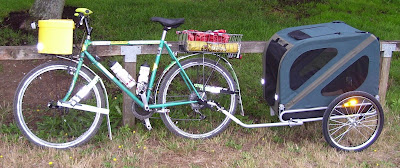A few days ago the US Secretary of Transportation, Mary Peters, was interviewed on the PBS program The News Hour. I didn't see this program when it was broadcast but thanks to the internet, the full transcript, audio and video of the interview are available here:
http://www.pbs.org/newshour/bb/transportation/july-dec07/infrastructure_08-15.htmlThe topic of conversation was infrastructure, something the nation's attention is focused on in large part because of the recent bridge collapse in Minnesota. But the parts of the interview that caught my attention and that of those of us who use bicycles to get around was this (bold emphasis added by Jonathan Maus in his excellent coverage of this at his
Bike Portland Blog):
GWEN IFILL: Aren’t many of those projects, even though they’re special interest projects, aren’t they roads and bridges, often? MARY PETERS: Gwen, some of them are, but many of them are not. There are museums that are being built with that money, bike paths, trails, repairing lighthouses. Those are some of the kind of things that that money is being spent on, as opposed to our infrastructure.
So it sure looks like Ms. Peters doesn't think bike paths and trails are part of the infrastructure. Well, maybe she just mis-spoke.
Uhhm, nope. That doesn't seem to be the case. Later, she says pretty much the same thing again:
GWEN IFILL: Who is spending the money inappropriately? MARY PETERS: Well, there’s about probably some 10 percent to 20 percent of the current spending that is going to projects that really are not transportation, directly transportation-related. Some of that money is being spent on things, as I said earlier, like bike paths or trails. Some is being spent on museums, on restoring lighthouses, as I indicated.
OK, so Mary Peters doesn't get it.
Now I've often said that it's hard to change a person's mind if the first thing out of your mouth are the words "You're wrong." but I've got to tell you, in this case, those are the words that came to my mind.
But I think I do understand a bit of what Mary Peters is thinking. And I think I understand because I never was that big a fan of bike paths and trails. In fact, I still have some mixed feelings about them.
I'm mostly a transportation cyclist. I use my bike to get to the places I need to go. I've often said that I don't expect people to build me paths everywhere I'm going to go. I'll often take a decent road with a good shoulder over a bike path. And a good road shoulder is better than a badly designed bike lane.
But here's the thing. Those bike paths and bike lanes actually do get people riding. It wasn't until I started working in bicycle advocacy and seeing the numbers and actually looking at the facilities that I really figured this out, but those paths and trails really do work.
They get more people riding. And not just riding for recreation but riding to go places. Maybe to work, maybe to the store. Maybe people start out riding on the paths and then become road riders. But the people do ride.
But short bits of infrastructure do help. Infrastructure isn't just about driving from place to place, it's about getting people from place to place. The Minnesota-based
Transit For Livable Communities provides some interesting facts:
Eight million U.S. households do not have a car. As many as 30 percent of us cannot drive because we are too young, too old, or physically impaired (1). For those who cannot or choose not to drive, bicycling and walking provide crucial access to goods, services and recreation. We could easily walk or bike more: Half the trips we make are less than three miles, 40 percent are less than two miles, and 28 percent are less than one mile (2). Yet 75 percent of trips of less than one mile are made by car (3).
Cities such as Minneapolis MN, Portland OR, and Vancouver BC which have invested in bicycle infrastructure all have higher rates people using bicycles for transportation than cities that have neglected to make such investments.
I commute to work daily via a bike path on the I-90 floating bridge. I ride through a tunnel that serves only pedestrians and cyclists. These facilities are not bits of pork, they are part of the infrastructure and they help people get to the places they need to go.
Bicycles and walking will certainly not replace automobiles for everyone or for every trip. But if people are provided with safe places to ride and walk rather than drive, some people will. And those people, making those choices to not drive are helping lessen our demand for foreign oil and decreasing our traffic congestion and air pollution.
The folks at
The League of American Bicyclists created this handy form that will let you send your comments to Ms. Peters:
http://capwiz.com/lab/issues/alert/?alertid=10193871&type=cuI just used the form to send her some of my civil thoughts on this issue. I urge you to do the same.
Keep 'em rolling,
Kent


























